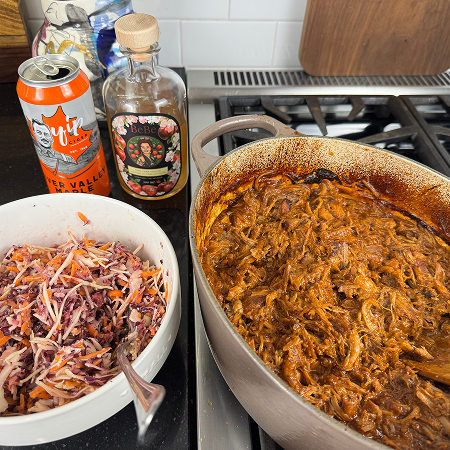
True coleslaw is an art form that balances texture, flavor, and visual appeal. This isn't the soggy, mayonnaise-heavy side dish of picnic nightmares, but rather a vibrant, crisp salad that stands proudly on its own.
There's a reason coleslaw has endured as a beloved side dish across cultures and cuisines. When executed properly, it provides the perfect textural contrast to rich, heavy foods while delivering a bright, acidic counterpoint that cleanses the palate. This recipe transforms humble cabbage into something extraordinary through careful technique and thoughtful ingredient selection.
The secret to exceptional coleslaw lies in understanding the science behind the preparation. By salting the shredded vegetables and allowing them to drain, you're removing excess moisture that would otherwise dilute the dressing and create that unpleasant watery texture that plagues inferior versions. This simple step ensures your coleslaw maintains its crunch and allows the flavors to penetrate properly.
The Foundation: Proper Preparation
Using a food processor to shred your vegetables ensures uniform pieces that blend harmoniously while maintaining individual character. The progression from green cabbage to carrots to purple cabbage isn't just about efficiency; it prevents the purple cabbage from staining the lighter vegetables while you work.
The addition of fresh apples elevates this coleslaw from ordinary to extraordinary. Their natural sweetness and crisp texture complement the vegetables beautifully, while their mild acidity harmonizes with the vinegar-based dressing. Honeycrisp apples are particularly excellent for this application, as they maintain their crunch and won't brown quickly.
The Essential Recipe
For the Slaw:
- 6 cups green cabbage, finely shredded
- 2 cups carrots, finely shredded
- 2 cups purple cabbage, finely shredded
- 1 teaspoon kosher salt
- 2 large Honeycrisp apples, shredded
For the Vinaigrette:
- 3 tablespoons extra-virgin olive oil
- 3 tablespoons BeBe Premium Apple Cider Vinegar
- 3 tablespoons Dijon mustard
- 3 tablespoons honey
- 1 clove garlic, minced
- ½ teaspoon celery salt
- Freshly cracked black pepper to taste
For the Garnish:
- 2-3 green onions, finely chopped
- 2 tablespoons toasted sesame seeds
Instructions:
Prepare the Vegetables: Using a food processor fitted with the shredding disc, process the green cabbage first, followed by the carrots, then the purple cabbage. This order prevents color bleeding and ensures uniform texture throughout.
Salt and Drain: Transfer the shredded vegetables to a large bowl and toss with the kosher salt. Set aside for 30 minutes to 1 hour. The salt will draw out excess moisture while beginning to soften the vegetables slightly.
Create the Vinaigrette: While the vegetables drain, whisk together the olive oil, BeBe apple cider vinegar, Dijon mustard, honey, minced garlic, celery salt, and freshly cracked pepper. The key is to emulsify the dressing thoroughly, creating a smooth consistency that will coat the vegetables evenly.
Drain and Combine: After the salting period, drain any accumulated liquid from the vegetables. This step is crucial for preventing a watery final product. Shred the apples using the same food processor disc and add them to the drained vegetables.
Dress the Slaw: Pour the vinaigrette over the vegetable and apple mixture, tossing thoroughly to ensure even distribution. The dressing should coat every strand without pooling at the bottom of the bowl.
Final Touches: Garnish with chopped green onions and toasted sesame seeds just before serving. These additions provide textural contrast and visual appeal while adding subtle flavor notes that complement the main ingredients.
The Art of Balance
This coleslaw achieves perfect balance through its carefully calibrated dressing. The BeBe Premium Apple Cider Vinegar provides the essential acidic backbone, while its complex, aged character adds depth that standard vinegars cannot match. The Dijon mustard contributes both tang and emulsification properties, while the honey provides natural sweetness that complements the apples without overwhelming the vegetables.
The celery salt is a subtle but important addition, providing the classic coleslaw flavor profile that many people recognize but can't quite identify. It bridges the gap between the fresh vegetables and the dressed salad, creating a harmonious whole.
Texture and Timing
The timing of this recipe is deliberately structured to ensure optimal texture. The initial salting period softens the cabbage just enough to make it pleasant to eat while maintaining its essential crunch. Adding the apples only after draining prevents them from becoming soggy while ensuring they remain crisp and bright.
The final garnishes should be added just before serving to maintain their individual textures and prevent the sesame seeds from becoming soggy. This attention to timing details is what separates exceptional coleslaw from the ordinary.
Versatility and Pairing
This coleslaw is the perfect companion to rich, fatty foods like pulled pork, fried chicken, or barbecue. Its bright acidity cuts through richness while providing textural contrast that makes each bite more interesting. The apple addition makes it particularly suited to autumn and winter menus, where it bridges the gap between summer's fresh salads and winter's heartier fare.
The recipe scales beautifully for entertaining, and actually improves slightly after a few hours as the flavors meld. However, it's best consumed within 24 hours for optimal texture and freshness.
The BeBe Difference
Using BeBe Premium Apple Cider Vinegar in this coleslaw isn't just about quality; it's about creating layers of apple flavor that work harmoniously with the fresh apples in the slaw. The vinegar's complex, aged character provides depth that enhances rather than masks the natural flavors of the vegetables.
This coleslaw represents the kind of thoughtful cooking that transforms simple ingredients into something memorable. It's proof that with proper technique and quality ingredients, even the most humble side dish can become a standout component of any meal.
